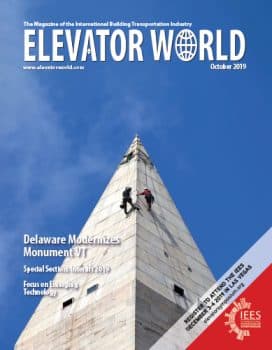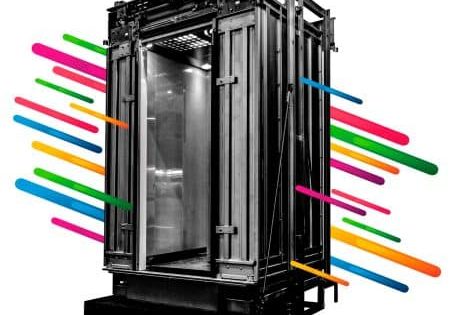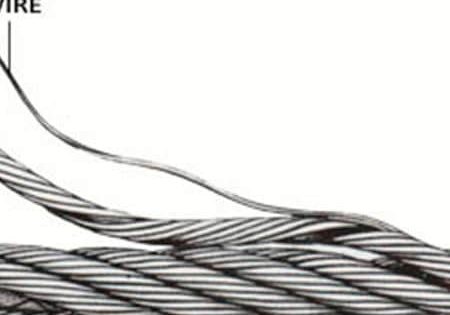Delaware Elevator leads a team in modernizing a VT system that has served the Washington Monument since the 1950s.
With more people than the population of the city of Seattle (800,000-plus) visiting the Washington Monument each year, the elevator serving it is a workhorse that makes more than a dozen round trips each day. Visitors from all over the world, including the occasional celebrity or dignitary, are drawn to the monument for the amazing views it affords. Its interior is decorated with elaborate limestone carvings — works of art themselves — visible from inside the elevator cabin. A modified 1959 DC gearless machine powers the almost-always-full elevator 500 ft up to an observation deck at the top of the marble obelisk — among the tallest freestanding masonry structures in the world, at 555 ft.
Although it’s hardly the monument’s first elevator (that was a steam-powered custom freight unit installed shortly after the monument opened in the 1880s), the system is in remarkable condition for its age and workload. Much of the system is characterized by “good bones”: the machine, of course, and the steel core framing the system, much of which is from the monument’s original 1885 construction.
When it was time for the most recent major elevator modernization at the monument, the National Park Service (NPS) hired Grunley Construction Co., Inc. to oversee the job. Grunley, in turn, called on Delaware Elevator, Inc. due to its previous work in the U.S. Capital, including at the Museum of the Bible, the Museum of the American Indian, National Air and Space Museum and the historic Old Patent Office Building, to name a few. With roots dating back to the 1930s, Delaware Elevator has grown into a powerhouse with more than 400 employees and numerous locations, including — near its Salisbury,
Maryland, headquarters — a training facility and a manufacturing division that produces a wide range of nonproprietary elevator systems including custom and standard equipment.
Previous (though not as extensive) monument modernizations occurred in 1997, when a new Motion Control Engineering (MCE) controller was installed; the early 2000s, when cab walls were updated with patterned stainless steel; and after the 2011 Virginia earthquake that damaged the marble and the counterweight system.
Various circumstances led the NPS to call for an in-depth evaluation of the elevator system, which experienced numerous problems leading to shutdowns. More than 100 pages long, a report by engineering firm CH2M Hill, Inc., which includes an extensive assessment from consultant Lerch Bates Inc., found that upgrades were needed to keep the VT system up to date with the latest technology and bring it into code compliance. Several components, such as the controls, electrical supply, structure for fire ratings and life-safety components, were not up to date with current code.
Machine-room access was a particular issue. The report observed:
“The elevator machine room is approximately 8 ft, 10 in. X 8 ft, 10 in. in size and is supported by steel framing with an aluminum diamond plate flooring surface. No permanent access to the elevator machine room is provided from the observation level; access is gained using a modified aluminum ladder extension permanently attached to the elevator machine-room support framing and a second portable extension ladder. The limited access is a concern for NPS staff and the elevator maintenance contractor…… It is likely the elevator’s performance issues are partially related to the difficulty in accessing the machine room and the associated safety issues.”
Was the VT system lubricated and well adjusted? Yes. Was it well kept and provided with adequate repair/ replacement parts? No, the report found. Some of the findings were things a layman could observe, such as keeping equipment cleaner and the machine room less cluttered. (Consultants found a dumbbell up there!)
Of the total time spent maintaining equipment, housekeeping requires roughly 60%, Lerch Bates said. The remaining time is spent on lubrication (15%) and component replacement/ repair (15%). Lerch Bates observed:
“While at first glance, [60%] would appear to be an excessive amount of time simply cleaning; it is time well spent. If a job is kept clean, the fire hazard (especially in hoistways) is lessened. Potential troubles and worn components are often detected during routine cleaning operations. Dirt is a major cause of elevator malfunction; a speck of dust between relay contacts can shut a unit down. Finally, a clean job makes routine inspection and maintenance easier.”
Due to chronic problems, including during peak tourist season, the elevator closed in August 2016.
The report suggested dozens of fixes and possible companies that could perform them (at least four of the big OEMs, for example). It observed the elevator was operationally safe and that no full-time technician was necessary. Some of the technology was outdated and unable to keep up with daily demand. The goals of the modernization, the report said, were to:
- Improve reliability
- Become code compliant to the maximum extent possible
- Improve machine-room access Delaware Elevator got to work in June
2018, and its technicians “rose to the occasion,” according to Delaware Elevator President Pete Meeks, completing the job in November 2018. Meeks said Grunley Construction “is to be commended on its excellence in overall project management, making sure all coordinated trades were operating at high levels.”
Existing stainless-steel doors with frosted glass panels were retained and reused. Many other players were involved, as the overhaul included refurbishment of the cab interior by Cab Solutions and the gearless machine by EMR of New Jersey, as well as new:
- Controller with destination dispatch (MCE)
- Fabricated structural components, brackets, (DEM) and miscellaneous parts
- Interior cab fixtures (Dupar Controls)
- Roller guides (Elsco)
- Travel cables and hoistway wiring (Draka)
- Hoist and speed governor ropes (American Lifting Products)
- Interior cab video media (Videotel)
- Deflector sheaves (Titan Machine)
- Door operator and hardware (GAL)
There were many custom components and challenging aspects to the job, including a remote troubleshooting controller designed and manufactured by MCE at Delaware’s request, as it was not part of the original scope of the works.
Delaware’s New Construction & Modernizations Field Operations Manager Jose Luis Carrasco said:
“Delaware Elevator wanted to provide a solution above and beyond the project’s specifications. The idea was to have a remote controller at the ground landing inside the fire command center, where the elevator technician is able to diagnose and reset some faults without needing to go to the elevator machine room, which is located at the top of the building. It was accessible only by using the stairwells, where the physical demand will bring heavy breathing while climbing 898 steps. An average person with a normal fitness level should take 30 min or more to reach the top of the building without stopping for a break. [The solution], the MCE iMonitor system, includes a camera in the machine room for maintenance/diagnostics from the ground floor.”
Should anyone need to climb all the steps and physically enter the machine room, permanent access to it is provided from the 500-519-ft level via a fixed ladder and a hung platform at the entrance to the machine room on the south side of the elevator shaft. This solution meets OSHA requirements for a fixed ladder and access platform.
The modernized elevator:
- Has 6800-lb capacity
- Has 500 ft/min speed
- Has 2:1 roping
- Makes two front and two rear stops
- Has two front and two rear openings
The modernized elevator debuted before a visit from First lady Melania Trump, whom Delaware lead mechanic and field superintendent Clayton Bennett got to meet. The first lady’s visit included a complete tour of the monument’s renovated elevator system.
Get more of Elevator World. Sign up for our free e-newsletter.









